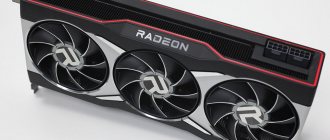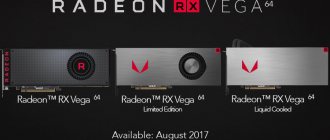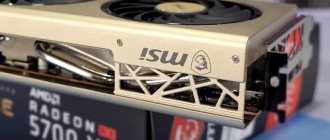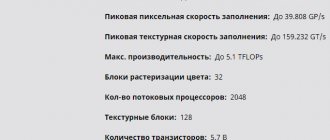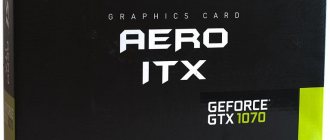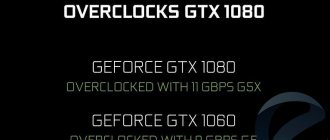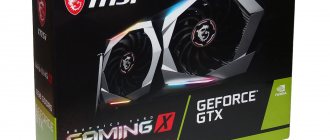The new video card from the 500 series of AMD is a modern and affordable device that uses all the company’s advanced technologies, as well as the new Polaris 12 processor. The company has not released products in the lower price segment for a long time, and finally, in the spring of 2017, The AMD Radeon RX 550 video card based on the brand’s most advanced processor at the moment was presented. Considering the period of calm, we should expect a noticeable gap with the models released in previous series in all respects.
Video card characteristics
The Radeon RX 550 is perfect for a desktop personal computer or home theater. Its distinctive features are good picture quality and support for all the most popular video formats with minimal heating, modest dimensions and reduced power consumption.
The cooling system copes well with the load. On the RX 550 video card, the fan does not spin if the operating temperature is less than 50°C. As soon as the processor overclocks due to increased loads and the temperature rises, the cooler starts working.
The purpose stated by the manufacturer is games in Full HD at medium quality settings. Unfortunately, it was not possible to make the video card passive, nor was it possible to do without an external power supply. The model is available in two versions: with a memory capacity of 2 Gb and 4 Gb. However, with a rather weak GPU, purchasing 4 GB does not make much sense; the processor will not allow you to use the volume to its full potential.
The main difference and feature of the model is the new Polaris 12 processor, which is part of the fourth generation of the GCN architecture. At this point in time, this is AMD's most advanced development. The RX 550 runs on a truncated version of the processor: of the 10 CUs available on the chip, only 8 are used, which significantly affects performance.
AMD is positioning the new product as a replacement for very outdated video cards that have not been upgraded in the past few years. For this reason, in tests the manufacturer compares the characteristics of the Radeon RX 550 not with the previous 400 series, but with the Radeon R7 250 and the like.
⇡#Clock speeds, power consumption, temperature, overclocking
The Radeon RX 550 easily maintains the maximum GPU frequency (1190 MHz in the case of the PowerColor card) in gaming tests and even under load in FurMark it hardly slows down (stable frequency - 1168 MHz).
The fan speed in Crysis 3 is kept at a moderate 1102 rpm, which is enough to keep the GPU temperature under 65°C.
But in terms of power consumption, the Radeon RX 550 is disappointing. In the gaming test, the new product is only 17 W more economical than the Radeon R7 360, although the TDP ratings of the video cards differ by 50 W. Also, the RX 550 turns out to be 6 W more power-hungry than the GeForce GTX 750 Ti, despite the fact that, according to the specifications, the TPD of the latter is 10 W higher (60 W versus 50). However, in FurMark the ratio between the Radeon RX 550 and GTX 750 Ti is quite consistent with the stated data: AMD has an advantage of 17 W.
Unfortunately, FurMark tests do not contain data from the Radeon R7 360. The utility simply does not run on a computer with the R7 360 sample used in comparison.
As for overclocking, for some reason controlling the frequencies of the PowerColor Red Dragon Radeon RX 550 and even monitoring the GPU supply voltage are impossible - either using the WattMan section in the AMD driver control panel or using third-party utilities. Most likely, this is a software problem in the driver or BIOS of the video card, due to the fact that this is a new model, and overclocking is not a priority function for GPUs of the lower performance category.
Radeon RX 550 review
AMD's main competitor in the fight for buyers is Nvidia. And the main competitor and analogue of the RX 550 from Nvidia is the GeForce GTX 1030. This model is closest to the RX 550: it will also not be able to handle powerful games and tasks that require high performance, and will also appeal to an undemanding user who prefers e-sports and Full HD movies .
Below is a comparative table of the main differences in technical parameters between the cards:
| Model | Radeon RX 550 | GeForce GT 1030 |
| Number of threads. processors | 512 | 384 |
| Number of TMUs | 32 | 24 |
| Number of rendering units | 16 | |
| Core frequency, GHz | 1.183 | 1,227-1,468 |
| Memory bus, bit | 128 | 64 |
| Memory frequency, GHz | 7 | 6 |
| Memory capacity, MB | 4096 | 2048 |
| Power, W | 50 | 30 |
Of course, it is correct to compare quantitative indicators only within one brand.
Since the architecture of devices can differ significantly, which means the “bigger is better” rule does not always work. In order to evaluate which card is better, you need to see both models in action. To do this, let's compare tests carried out in three games: Batterfield 4 and 1, as well as Dota 2. For comparison, the first mission in Butterfield 4 was taken at the moment after the wall was blown up. Both video cards were tested during a run to an area with thickets, before descending to a construction site. The graphics were in high quality mode with anti-aliasing disabled.
In Butterfield 1, the test was carried out with average graphics quality on the scene from the beginning of the mission “With all our might” at the time of controlling a tank while attacking an enemy position.
Dota 2 was tested while playing a tournament game. For the calculation, a recording of 70 seconds was used, which was played several times for a more accurate result. Testing was carried out with high picture quality and shadows.
For the final calculation, the peak values of each run were taken, which were then summed and divided by the number of tests to find the arithmetic mean. Based on the results of the comparison in Batterfield 4, the GeForce GT 1030 turned out to be 5-15% weaker than the Radeon RX 550.
In Battlefield 1, the GeForce GT 1030 easily overtook the Radeon RX 550 at standard frequencies. In Dota 2, the GT 1030 outperformed its competitor by 20%.
Thus, the card from Nvidia either shows similar results or is slightly inferior to the RX 550. However, if you consider that the GT 1030 is somewhat cooler in the passive case than the Radeon model and does not have problems with decoding VP9, unlike the RX 550, then the conclusion suggests itself that the GT 1030 still outperformed its competitor, albeit slightly.
⇡#Performance: video decoding
Unexpectedly, the Radeon RX 550, having lower frequencies than the Radeon RX 580, turned out to be faster in the task of video decoding. Apparently, the developers made some optimizations to the logic of the hardware codec after the Polaris 10 and Polaris 11 chips were designed. Thanks to this, AMD almost halved the gap behind NVIDIA when decoding the H.264 standard. When decoding HEVC, the Radeon RX 550 does not fare as well, but the speed is quite sufficient to play back a stream at up to 60 fps at 4K resolution.
Note: since decoders within the same GPU line usually do not differ, the diagrams show one device from each family (or more if this rule is violated).
The results of GPU computing tests, as most other comparisons within the same price category show, contradict each other. The Radeon RX 550 outperforms the Radeon R7 360 in single-precision performance in Sandra and water simulation. In the rest of the benchmarks, the Radeon R7 360 took the lead. The GeForce GTX 750 Ti, in turn, outperforms the new product in LuxMark and particle physics calculations. The APU results, as you might expect, are quite modest compared to discrete video cards, especially when rendering video in Sony Vegas, which relies much more on CPU resources than on the GPU.
Improving mining performance
The low bandwidth of the video card, due to the 128-bit bus and low clock frequency, leaves practically no options on how to overclock the RX 550 series video card for mining. You definitely shouldn’t expect high profits from using it.
In order to use the Sapphire PULSE video card for mining, you need to download the latest driver update from the manufacturer's website. The process will be carried out using the Ethereum algorithm in dual-mining using Claymore. Heating at full load will be 55-65°C.
In the settings of the MSI Afterburner utility, select the GPU frequency equal to 2000 MHz. With the given settings, the RX 550 produces a speed of 9.8-10.5 megahashes. Considering the budget price of the model, it is quite possible to buy it as inexpensive additional equipment for the farm.
Mining on an AMD Radeon RX 550 video processor manufactured by Gigabyte with 2 GB of memory at a maximum core overclock of 1405 MHz and a memory frequency of 1750 MHz will produce 79 sols or 270 hashes/sec.
A budget video adapter from Asus with a memory capacity of 4 GB in maximum overclocking mode and a cooler speed of 80% demonstrates a temperature reading of 67°C. Using Claymore on the Ethereum algorithm, it produces an acceptable figure - 10.2-10.6 megahashes per second. For its price, it fully lives up to expectations and allows you to quickly recoup your investment.
What to mine
Due to the relatively average characteristics of the market, both 4Gb and 2Gb versions of the RX 550 are not capable of mining bitcoins, but mining lesser-known currencies is possible. Thus, the card is suitable for novice miners who have not yet mastered all the intricacies of this industry.
Current service for calculating profitability:
How to configure a card for different algorithms and programs
If the role of a graphics card for mining falls on the RX 550 2 Gb, then its use will only be possible for XMR algorithms and coins where the DAG file does not exceed 2GB (Ubiq, Expanse, Pirl, Ellaism, Metaverse, Callisto), because this card is capable of processing only a directed acyclic graph of the ether.
The mining test for this card showed that the core is maximally overclocked to 1405 MHz, and the memory frequency is stable at 1750 MHz. With these settings, the RX 550 shows about 280 H/s on Monero. This is not enough, but the card can pay for itself, but after a long period of time.
- The 4 Gb video card was compared using the same test.
The cooler speed was set to 80%. The temperature was approximately 65%. Using Claymore's Dual Ethereum AMD+NVIDIA GPU Miner with the Ethereum algorithm, the Rx 550 produced a good result of 10.5 MN/s. The card has fully justified itself, since, having a low price, it can quickly pay for itself and start working in “+”.
Game testing
Radeon Chill technology has been added to the new firmware for AMD video cards, thanks to which the user can significantly reduce the power consumption of the video card and GPU heating without compromising picture quality and without losing a comfortable gaming mode.
The essence of the technology is that when the player does not perform actions, the program reduces the number of frames, thereby reducing the load on the video card. And as soon as the user returns to active mode, the image update speed returns to normal. All this happens completely unnoticed by the user.
Radeon RX 550 gaming tests demonstrate the technology's effectiveness in CS:GO, Dota 2, League of Legends and other popular eSports games.
In addition to the games already mentioned, the RX 550 will run:
- Batterfield 1, 4;
- Dirt 4;
- Fallout 4;
- Grand Theft Auto 5, etc.
The video card was created with a focus on eSports, so the RX 550 will perform well in online games designed for average resource consumption.
Fresh drivers
You can download drivers for the Radeon RX 550 video card for Windows 7 and Windows 10 operating systems on the official AMD website in the “Radeon RX 550 Drivers” section. You can also download the necessary drivers on our website by clicking on the link, or on the websites of video card manufacturers: Sapphire, Gigabyte, Asus and MSI.
For Windows 7, 8.1, 8 and Vista
For Windows 10
| 32-bit | 64-bit |
File size:
25.00 MB Driver version: 11.18.1 from 11/8/2018; Language: Russian Operating system: Windows 10 32/64-bit, Windows 7 32/64-bit, Windows 8.1 32/64-bit, Windows 8 32/64-bit, Windows Vista
Comparison of parameters and prices from different manufacturers
The table shows the comparative characteristics of Radeon RX 550 video cards from four manufacturers, as well as the retail price of each of them.
| Model Radeon RX 550 | Gigabyte D5 | ASUS | MSI | Sapphire Pulse |
| Retail price, rub. | from 6500 | from 8000 | from 5800 | from 6500 |
| GPU | Polaris 12 | |||
| GPU clock frequency (base), MHz | 1.183 | 1.183 | 1.203 | 1.206 |
| Memory | 2049/4096 MB | 2049/4096 MB | 2049/4096 MB | 2049/4096 MB |
| Maximum resolution | 7680×4320 | 5120×2880 | 7680×4320 | 3840×2160 |
Today, the choice of a video card is influenced not so much by its individual characteristics as by the availability of a particular model in the store.
Due to the huge excitement around video adapters in the wake of the popularity of mining, many large retail chains have completely excluded this section from their online catalogs. Fortunately, budget models such as the RX 550 were virtually unaffected by this problem, and even their prices remained at an acceptable level.
Hashrate
Hashrate is a unit of measurement that determines the computing power of a video card in mining. The higher it is, the better. The hashrate may vary depending on the coin the card is mining. Details are in the table below.
| Coin | Algorithm | Hashrate |
| Expanse (EXP) | DaggerHashimoto EXP | 14.5MH/S |
| Ubiq (UBQ) | Ubqhash | 14.5MH/S |
| Ravencoin (RVN) | KawPow | 3.5MH/S |
⇡#Conclusions
After AMD began to produce central processors with a relatively large graphics core, the threat of extinction loomed over low-end discrete video cards. And the history of game consoles, each of which in the current generation is equipped with a system-on-chip, has shown that the level of performance that AMD offers in desktop CPUs is far from the limit of the capabilities of integrated graphics. Intel also explored this direction in Broadwell desktop processors. But in the end, despite the early successes of APUs, both x86 processor manufacturers no longer offer retail chips with powerful integrated GPUs for entry-level gaming systems. As a result, the development of low-cost discrete video cards has resumed.
For its price, the Radeon RX 550 demonstrated quite decent gaming performance. Even with maximum graphics settings, many AAA-class projects, at the very least, work on the Polaris 12 chip (an adequate amount of local memory plays an important role in this - 2 or even 4 GB), and there is nothing to say about undemanding online games.
In addition, the RX 550 has a full set of multimedia functions of the Polaris family, including DisplayPort 1.3/1.4 interfaces, HDMI 2.0 with HDR support and high-compression video decoding - HEVC and VP9. In fact, the hardware codec in Polaris 12 is even faster than in older AMD GPUs. All that remains is to once again complain that software support for VP9 is still missing in the AMD driver.
The only complaint we have with the Radeon RX 550 is related to its power consumption. In absolute terms, this is, of course, a low-watt video card that does not require an additional power connector or a developed cooling system. But in this class, if we consider not the maximum power, but the typical power consumption in games, such an old accelerator as the GeForce GTX 750 Ti is both faster (provided that the game requires 1 GB of RAM) and more economical than the Radeon RX 550.
